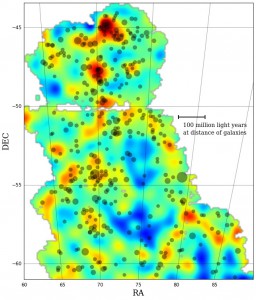Mapping the cosmos: Dark Energy Survey creates detailed guide to spotting dark matter
On 14. April 2015 Scientists on the Dark Energy Survey have released the first in a series of dark matter maps of the cosmos. These maps, created with one of the world’s most powerful digital cameras, are the largest contiguous maps created at this level of detail and will improve our understanding of dark matter’s role in the formation of galaxies. Analysis of the clumpiness of the dark matter in the maps will also allow scientists to probe the nature of the mysterious dark energy, believed to be causing the expansion of the universe to speed up. This analysis was led by Vinu Vikram of Argonne National Laboratory (then at the University of Pennsylvania) and Chihway Chang from the Institute for Astronomy of ETH in Zurich. Vikram, Chang and their collaborators at Penn, ETH Zurich, the University of Portsmouth, the University of Manchester and other DES institutions worked for more than a year to carefully validate the lensing maps. The dark matter map released on 14. April 2015 makes use of early DES observations and cover only about three percent of the area of sky DES will document over its five-year mission. The survey has just completed its second year. As scientists expand their search, they will be able to better test current cosmological theories by comparing the amounts of dark and visible matter. You can view the Dark Energy Survey analysis here. More information on the Dark Energy Survey is available here and. We also recommend for reading the article titled “Shedding light on dark matter” published on the ETH News.
